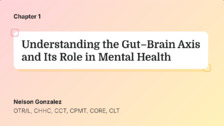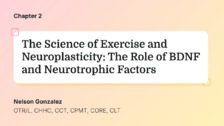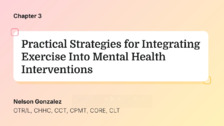Move Your Mind: Exploring the Impact of Exercise on the
Gut-Brain Axis (Recorded Webinar)
Presented by Nelson Gonzalez

12-Month Subscription
Unlimited access to:
- Thousands of CE Courses
- Patient Education
- Home Exercise Program
- And more
This course is a recording of a previously hosted live webinar event. Polling and question submission features are not available for this recording. Format and structure may differ from those of standard Medbridge courses.
Are you aware of the powerful connection between exercise and mental health? The gut–brain axis plays a pivotal role in brain function, cognition, and emotional well-being, yet its relationship with physical activity remains vastly underexplored in clinical settings. This webinar bridges a crucial practice gap by diving deep into the science of how exercise can directly influence gut health, improve brain function, and alleviate symptoms of anxiety, depression, and cognitive decline.
As a healthcare professional—whether you’re a physical therapist, occupational therapist, nurse, speech therapist, or social worker—you play a vital role in guiding patients through holistic approaches to mental health and rehabilitation. This session will equip you with the latest evidence on the gut–brain connection and actionable strategies to incorporate exercise into patient care plans for optimal mental and physical outcomes. Don’t miss the opportunity to stay ahead of the curve in understanding how movement influences brain health—because if you’re not leveraging the gut–brain axis in your treatments, you’re missing out on a game-changing approach to patient well-being.
- Define the gut–brain axis, and explain its role in mental and cognitive health
- Identify how exercise impacts the gut microbiome and its effects on mental well-being
- Recognize the benefits of exercise for improving cognitive function and mental health outcomes in patients
- List strategies to incorporate movement-based activities into meaningful occupations such as work, self-care, or social participation to support mental well-being
Meet your instructor

Nelson Gonzalez
Nelson been an occupational therapy practitioner for more than 19 years, with an array of certifications and specialties, including rehabilitation fitness specialist, certified holistic health coach, certified cupping therapist, certified pediatric massage therapist, certified oncology rehabilitation expert, LSVT-BIG, and…
Chapters & learning objectives

1. Understanding the Gut–Brain Axis and Its Role in Mental Health
This chapter introduces the gut–brain axis, explaining its critical function in regulating brain health, emotions, and cognitive performance. Participants will gain an understanding of the bidirectional communication between the gut and brain and how exercise can influence this connection, ultimately promoting mental well-being. Insights into the gut microbiome’s impact on brain function will empower practitioners to consider exercise as an essential tool for improving patient care.

2. The Science of Exercise and Neuroplasticity: The Role of BDNF and Neurotrophic Factors
This chapter dives into the science of exercise-induced neuroplasticity, focusing on the role of brain-derived neurotrophic factor (BDNF) and other neurotrophic factors. Participants will explore how exercise stimulates the production of BDNF, which supports brain cell growth and improves cognitive function, emotional regulation, and resilience to stress. Additionally, the chapter will highlight how exercise affects the gut microbiome, with implications for enhancing mental health outcomes, particularly in patients with anxiety, depression, or cognitive decline.

3. Practical Strategies for Integrating Exercise Into Mental Health Interventions
This chapter provides actionable strategies for clinicians to incorporate exercise into their patients’ care plans. It will cover different types of physical activity, including aerobic exercise, strength training, and mindful movement, and how each modality can support mental health. Special attention will be given to tailoring exercise interventions for diverse patient needs, from those with chronic mental health conditions to those seeking preventive care. By the end of this chapter, participants will feel empowered to integrate exercise into therapeutic practices for improved patient outcomes.

4. Question & Answer Session
This chapter is a viewer-submitted question and answer session facilitated by Nelson Gonzalez.